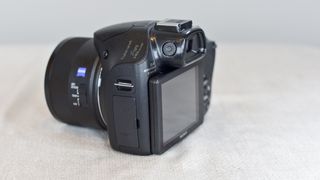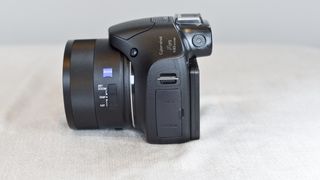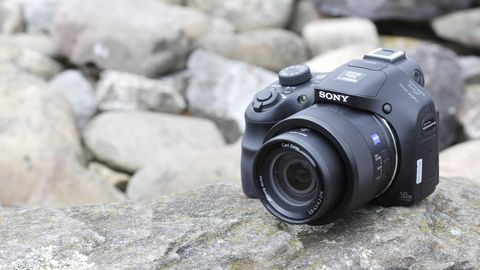Why you can trust TechRadar
As already mentioned, the outward construction of the HX400 remains pretty much the same as the HX300.
The grip is a chunky affair, while the textured coating helps it feel secure in the hand and gives it a higher quality appearance.
The styling of the camera is very much in the DSLR camp, with a mode dial on the top of the camera to quickly switch between different exposure modes, such as fully automatic, superior auto and movie mode.

There's also full manual control available from here, along with aperture priority and shutter priority modes. Handily, there's also space for up to two groups of customised settings, in case you often find yourself shooting one particular type of scene, such as low light.
Unsurprisingly due to its huge focal length, the lens is the largest element of the camera. Traditionalists will no doubt enjoy the fact that you can zoom using the lens itself. If you prefer though, you can use a switch around the shutter release button.
Zooming itself is fairly fluid and smooth, which is useful when you need to zoom back in and out when composing an image of a subject in the distance.

Just within handy reach by the thumb, on the back of the camera, is a scrolling dial that you can use to change the aperture or shutter speed, depending on the mode you're shooting in.
Sony is big on customisation, with most of its compacts and compact system cameras offering the ability to change the operation of the camera depending on what your preferred method of working is.
There's a function button on top of the camera, just in front of the mode dial and behind the shutter release button. It's easy to reach with your finger, and it brings up a sort of quick menu, which has a number of oft-used functions assigned to it, including white balance and sensitivity.

You can change these around, or switch them for different functions altogether if you prefer. Next to the function button is also a custom button, which can be assigned to one particular function, such as Wi-Fi options.
On the back of the camera is a traditional four-way navigational pad, with each of the directions assigned to a different function. For instance, up controls the camera's display, while the down button accesses exposure compensation.
Unlike some of the other Sony cameras out there, these buttons can't be customised to something different, but it's still a sensible arrangement of the options.
Also on the back of the camera is a Menu button for accessing the main menu. Sony has recently decided to unify all of its menu systems throughout its range, so if you've used a Sony DSLT, CSC, or even another compact camera recently, you'll be at home here.
If you haven't, it can take a little bit of time to get used to the way the menu works, but for the most part it's sensibly arranged into different tabs. You may find you don't need to use it all that often anyway, since the quick menu – accessed by the function button – does the majority of jobs you need.
As there's no touchscreen, changing the AF point has to be done via buttons. First of all, you'll need to set the Focus Area mode to flexible spot. Once you've done that, you can use the centre button in the navigation pad to bring up the point, and then the directional keys to scroll around to the point you need.
You can also adjust the size of the point by using the dial on the back of the camera. Although this process isn't quite as fast as it is on cameras with a touchscreen, it's still relatively quick once you've set it up.
Not only does the camera have a tilting screen, but it also has an electronic viewfinder. The viewfinder has a sensor that automatically detects when the camera has been lifted to your eye. This works well to provide a seamless transition, but if you're using the screen tilted downwards to take a picture from a low angle, you may find you need to be careful that your body doesn't cause the sensor to switch the camera off.
Amy has been writing about cameras, photography and associated tech since 2009. Amy was once part of the photography testing team for Future Publishing working across TechRadar, Digital Camera, PhotoPlus, N Photo and Photography Week. For her photography, she has won awards and has been exhibited. She often partakes in unusual projects - including one intense year where she used a different camera every single day. Amy is currently the Features Editor at Amateur Photographer magazine, and in her increasingly little spare time works across a number of high-profile publications including Wired, Stuff, Digital Camera World, Expert Reviews, and just a little off-tangent, PetsRadar.


